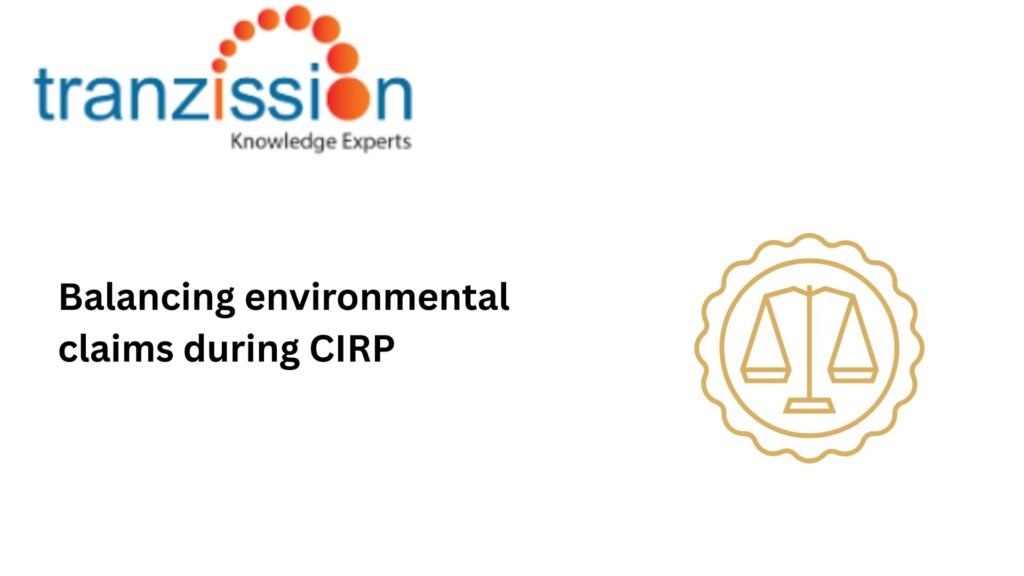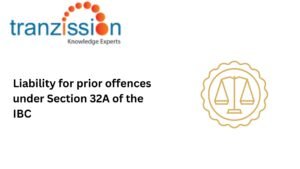
Balancing environmental claims during CIRP

Table of Contents
Insolvency and restructuring procedures involves financial considerations in addition to the legal proceedings and costs. But environmental sustainability require more than just financial backing as it affects general public as well. Environmental claims are proceesed under the corporate insolvency resolution process, but they are difficult to be part of insolvency proceedings as they are unliquidited and hard to determine. Understanding the reasons behind the challenges of handling environmental claims for insolvent companies and the legal barriers of their inclusion in the insolvency process, it is important to know the insolvency framework in India.
Environmental Claims in the Context of Insolvency
The intersection between environmental regulations and insolvency law can be complex, due to different interpretations and legal frameworks depending on the jurisdiction. This creates confusion regarding the liability and how to enforce environmental claims.
What Are Environmental Claims?
Environmental claims arise when a company harms the environment and cannot pay for the damages. It includes claims related to environmental damage caused by corporate activities, including pollution control, ecological restoration, and liability for hazardous waste disposal. Environmental claims are categorised as contingent claims or decree holders under the IBC.
Read more : Offences and Penalties under IBC, 2016
The Rising Relevance of Environmental Claims
The t growing global emphasis on sustainable development has pushed for environmental accountability even during insolvency. The relevance of environmental claims under the IBC is due to the growing concerns about climate change and the need to hold companies accountable for their environmental liabilities. In India, cases such as Sterlite Industries have highlighted the environmental repercussions of corporate insolvencies.
Challenges in Addressing Environmental Claims
Addressing environmental claims under the IBC presents significant challenges due to the complexity of managing insolvency law with environmental claims and the difficulty of accurately assessing the cost of environmental damage. The link between environmental regulations and the IBC can be unclear which results in uncertainties regarding the treatment of environmental claims in insolvency proceedings. Under the waterfall mechanism in IBC, financial creditors have priority over environmental claimants, which are operational creditors, leads to such claims being ‘contingent’.
Legal Framework Governing Environmental Claims in India
Insolvency and Bankruptcy Code, 2016
IBC does not explicitly prioritize environmental claims, leading to challenges in addressing ecological liabilities. Environmental claims are rarely included in resolution plans as the resolution professionals have to value contingent claims to include them in the resolution plan. Section 53 of the IBC prioritises financial creditors over operational creditors, which includes environmental claimants.
Environmental Laws
The legal framework in India does have laws specifically for environmental matters, such as the Environment (Protection) Act, of 1986, a comprehensive framework for environmental protection, the Water (Prevention and Control of Pollution) Act, of 1974, and the Air (Prevention and Control of Pollution) Act, 1981. However, they fail to impose obligations on companies for environmental restoration during insolvency. The current insolvency framework also does not address the conflict between these Acts and the IBC.
Read more: What you need to know about insolvency and the healthcare sector
Judicial Precedents
Environmental claims can be classified into contingent environmental claims and environmental decree holders. As per the decision of Tripura High Court in Sri Subhankar Bhowmik Vs. Union of India, environmental decree holders would be classified as low-priority unsecured creditors under the header ‘other debts and due’. Therefore, Indian courts have acknowledged the significance of environmental claims but have yet to establish consistent jurisprudence on prioritising them in insolvency cases.
Global Practices in Balancing Environmental Claims
United States:
Chapter 11 of the U.S. Bankruptcy Code explains the legal process of reorganisation bankruptcy which allows a company to restructure its finances and operations while continuing to do business. Under this Chapter, environmental obligations are treated as administrative claims which gives them higher priority in comparison to Indian insolvency laws.
European Union
The European Union (EU) has a common framework for insolvency proceedings, regarding cross-border insolvency cases, that was updated in 2015. The new rules overcome financial difficulties while protecting creditor’s rights. The EU insolvency framework integrates environmental accountability by imposing penalties for non-compliance with ecological obligations during insolvency proceedings.
Lessons for India
As per the environmental laws in India, if an entity harms the environment, they bear the cost of clean-up. If the entity defaults on the compensation payment or is unable to pay, then it may be declared ‘insolvent’ under the IBC. However, there is still a lack of a framework suitable for environmental claims. India can adopt global practices by amending the IBC to provide higher priority to environmental claims and incorporating sustainable restructuring practices.
Prioritizing Ecological Concerns in Insolvency
Because of the gaps in insolvency laws, it is important to prioritise ecological concerns in insolvency, which include addressing environmental liabilities when a company is going through insolvency proceedings. This will ensure that environmental damage is not looked over during the distribution of proceeds under section 53 of the IBC.
- The foremost step should be revising the priority list under the IBC to include environmental claims as secured debts to ensure better accountability.
- There is a requirement that insolvent companies must thoroughly assess environmental audits to assess ecological damages and liabilities through independent auditors.
- Being a contingent claim, environmental claims are often not a part of resolution plans. Therefore, it is necessary to promote green investments and sustainable practices as part of corporate restructuring plans during insolvency proceedings.
Key Challenges in Addressing Environmental Claims
There are many legal, regulatory, and financial challenges in accurately handling environmental claims during the corporate insolvency resolution process (CIRP):
- Financial vs. Environmental Priorities: Under section 53 of the IBC, the order of creditor payments lists financial claims the first to be paid from the proceeds of the sale of the company’s assets. As environmental claims are classified as contingent claims they are considered ‘low priority’ and are paid after the financial creditors, leaving limited resources for environmental restoration.
- Lack of Expertise: Insolvency professionals may not have sufficient knowledge regarding environmental liabilities, leading to the underestimation of certain claims during the insolvency process. Hence, insolvency professionals may not correctly address complex environmental claims.
- Implementation Issues: Enforcing environmental claims during insolvency often encounters practical challenges due to the lack of available funds to cover environmental liabilities and limited regulatory oversight to ensure the such claims are addressed properly.
Policy Recommendations for Addressing Environmental Claims
- Establishing a Green Fund: Companies should allocate funds for certain activities that might contribute to insolvency. Establishing a ‘green fund’ to dedicate capital specifically used to invest in enviornmentally sustainable projects, which can help avoid potential insolvency by mitigating climate-related risks.
- Training for Insolvency Professionals: The Insolvency and Bankruptcy Board of India (IBBI) can introduce specialised training for insolvency professionals to evaluate and manage claims effectively. They can introduce course or programs to improve their knowledge and skills on how to manage environmental claims, the risks that might be associated with these insolvent companies, and tips on navigating the legal complexities in such matters.
- Amending the IBC: Section 238 of the IBC does mention that IBC will have precedence over any other law that conflicts with it. The overriding affect of the IBC provisions is reflected through judicial precedents, which in environmental claims has not been given yet. Therefore, it is necessary to include provisions for prioritizing environmental claims and incentivizing sustainable restructuring practices.
Case Studies and Insights
- In India: In 2013, Sterlite Industrites was found liable for polluting the environment near its plant. The company was responsible for a suflur dioxide lead that caused health issues for nearby residents. The Tamil Nadu authorities shut down the factory in 2013 and again in 2018 for violating license conditions.The company estructuring involved reorganised a company’s legal, operational, or ownership structures to make it more profitable or better organised. This case highlighted the conflict between financial restructuring and environmental accountability. The lack of prioritization for ecological claims led to public outcry and policy discussions.
- In the U.S.: In the insolvency of Deepwater Horizon oil spill, BP, the primary company responsible, did not face insolvency but settled a large number of environmental claims through a record-breaking settlement in the U.S. government, totalling over $20 billion. The court in this case addressed environmental claims through a comprehensive framework under Chapter 11, setting an example for balancing financial and ecological priorities.
The Future of Environmental Claims in the Indian Insolvency Framework
It is clear that there are ambiguities and gaps that environmental laws were not considered when the IBC was enacted, therefore the intersection between environmental laws and the IBC was overlooked. India can learn from Chapter 11 of the US Bankruptcy Code and change environmental claims into higher priority claims under section 53 of the IBC and ensure that they are mentioned in the resolution plan. To introduce the necessary reforms to address the issue of environmental claims under the IBC, India can refer to the insolvency framework under the E.U. on cross-border insolvency.
Conclusion
The integration of environmental claims into insolvency proceedings represents a paradigm shift towards sustainable restructuring. While India’s current insolvency framework lacks adequate provisions for prioritizing ecological concerns, global practices and judicial precedents offer a roadmap for reform.





